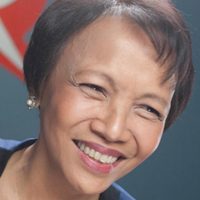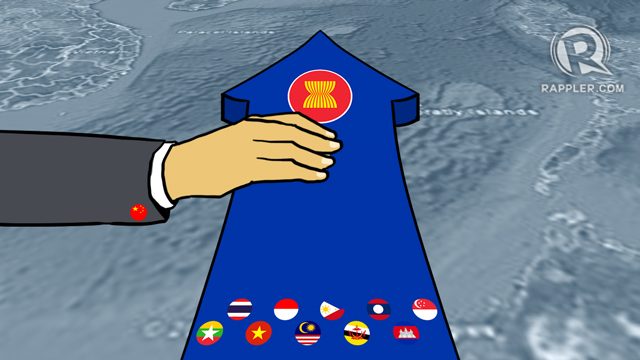SUMMARY
This is AI generated summarization, which may have errors. For context, always refer to the full article.

When we reach the age of 50 – that’s half a century old – we tend to ask ourselves profound meaning-of-life questions. So should organizations like ASEAN.
As it marks its 50th year, it needs to reflect on an existential question: can ASEAN ever have a united voice on South China Sea and achieve peace in these contested waters?
For, through the years, ASEAN has not been effective on the South China Sea issue on two counts:
- First, the consensus rule in ASEAN and the powerful clout of China have made it painfully difficult for these parties to arrive at a legally binding Code of Conduct on the South China Sea.
- Second, the ASEAN-China Declaration of Conduct on the South China Sea of 2002 is famous for being breached rather than observed.
1990s

Since the 1990s, a pragmatic ASEAN has chosen to engage China in talks as some member countries have competing claims with this powerful country over parts of the South China Sea.
I liken this engagement with China as ASEAN’s dance with the elephant. It’s a slow drag and it gets straining at times and repetitious, too. There may be high points, when they sway to the same tune, but there are also low points, when the elephant’s paws step on ASEAN’s toes because they are dancing to different beats.
In 1992, Beijing hardened its expansive claims on the South China Sea. It passed a law explicitly asserting its sovereignty over the Spratly Islands.
ASEAN regarded this as a warning sign that China seemed set on a collision course with other claimant countries. Manila thus took the lead in urging its co-members in ASEAN to call for restraint and find a peaceful resolution to the disputes.
In the same year, the ASEAN Declaration on the South China Sea was crafted in a foreign ministers’ meeting in Manila. It was their first statement of concern on the disputed area and was signed by the 5 original members – Indonesia, Philippines, Thailand, Malaysia, and Singapore – and the newcomer Brunei. They highlighted the need to settle issues without the use of force. This document was referred to as the Manila Declaration.
To cap the declaration, the ASEAN ministers proposed a “code of international conduct over the South China Sea.” This may have been the first time such a code was mentioned.
China endorsed the Declaration’s principles.
Mischief Reef
But something happened that shocked the Philippines and the rest of ASEAN.
The Chinese quietly occupied Mischief Reef (Panganiban Reef), which lies within the Philippines’ exclusive economic zone (EEZ). In late 1994, they began setting up structures and flew the flag of the People’s Republic of China. It was a full-fledged presence, with many vessels anchored and about 1,000 uniformed men in the area.
As China was beefing up its presence in Mischief Reef, Filipino diplomats kept up the pressure on their counterparts.
Official communications between Manila and Beijing on this source of friction were all documented. These historical records were annexed to the Philippine memorial submitted to The Hague – made public for the first time in 2013 when the government filed its case versus China.
The Philippines was confronting a rising power whose economy was growing fast. China’s newfound wealth gave the Asian giant the luxury to look beyond its borders and strategize its role overseas.
China’s action on Mischief Reef also showed that power abhorred a vacuum. When the Philippines drove away the American military bases in 1992, China saw an opportunity to slide its way in.
The Philippines ran to ASEAN for help in 1995. The ASEAN foreign ministers issued a statement expressing “serious concern” and urged all parties to “refrain from taking actions that destabilize the region.”
2002 Declaration
Fast forward to 2002: the Declaration on the Conduct of Parties in the South China Sea, or DOC for short, was drafted in 2002 as a modus vivendi between China and ASEAN to placate tensions.
The 3-page DOC, which was a product of tedious negotiations for about two years, called for resolving territorial disputes by peaceful means and continued dialogues and “regular consultations on the observance of this Declaration.”
Overall, it was a confidence-building measure. But it wasn’t what the parties really aimed for.
While ASEAN and China were inching their way to the real thing, a Code of Conduct or COC, they decided to come up with the DOC, a sort of mid-way point to show sign of progress.
Thus the DOC was simply a stopgap measure, a document that would serve as a bridge to the goal of coming up with a COC that would bind countries to specific commitments in being made accountable for violations each one commits.
This Code had been on the agenda of ASEAN and China for, on and off, more than 20 years, but with no final agreement yet in sight.
As events unfolded, China took the view that the DOC was not a matter between China and the ASEAN as a whole but remained a bilateral issue. This was in contrast with the view of ASEAN. Therein lay a major incompatibility.
Phnom Penh and Kunming
Ten years after the Declaration, something happened that went against the tenets of the DOC.
In 2012, China took control of Scarborough Shoal. The balance of power was as clear as day.
The ASEAN foreign ministers’ meeting that followed in Phnom Penh turned out to be historic. For the first time in 45 years, ASEAN did not issue its customary joint communiqué. It was the most unexpected thing to have happened in the predictable history of ASEAN.
Cambodia, then the ASEAN chairman, refused to include any mention of the Scarborough Shoal incident in the concluding statement – even if the shoal wasn’t named. Consensus, which was the norm in ASEAN, couldn’t be reached.
This incident scarred ASEAN, posing a challenge to the group’s unity in the wake of China’s tightening clout.
A similar incident happened in the Chinese city of Kunming in 2016 during the meeting of foreign ministers of China and ASEAN. The Malaysian foreign ministry released a strongly-worded statement by the ASEAN – that did not name China directly – but warned against undermining peace in the South China Sea. At the time, China had been building artificial islands and increasing its military presence.
But the statement was recalled. This was an unprecedented U-turn. The press called it the case of the vanishing ASEAN statement.
China, reports said, put pressure on its two allies, Cambodia and Laos, to block the statement.
One-page draft ‘framework’
Today, where is ASEAN in terms of reaching a legally binding Code of Conduct?
In early 2017, the most that ASEAN and China reached was a one-page draft “framework of a COC” which did not stray from the 2002 Declaration. If you read it, it sounds pretty much like the DOC, with a bit more detail.
The aimed-for COC, the draft says, should be able to establish rules to “manage incidents” and create a positive environment for peaceful settlement of disputes – through hotlines and measures to build trust. These should be monitored via mechanisms still to be agreed upon.
The prospects for a COC do not seem bright. This remains a huge test for ASEAN. Which brings me back to the existential question: will ASEAN ever be effective in speaking up with a united voice on the South China Sea and ultimately bring peace to the disputed waters?
This question hangs like a fog over ASEAN. Only the association, through a reboot of its ways, can lift this fog. – Rappler.com
Marites Dañguilan Vitug, editor at large of Rappler, is currently a visiting scholar at the National Graduate Institute of Policy Studies (GRIPS) in Tokyo. These are excerpts from her talk in the keynote panel of the seminar “ Visions of Regionalism, Realities of Regionalization” held in GRIPS on Wednesday, November 22.
Add a comment
How does this make you feel?
There are no comments yet. Add your comment to start the conversation.